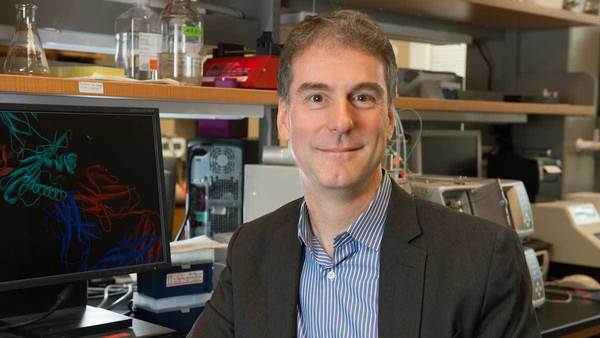
Scientists at the University of Notre Dame contributed to research published in Nature Medicine outlining the identification of a long-sought-after class of molecules that may lead to the development of widespread and less expensive new cancer therapies that engage the immune system.

Brian Baker, Coleman Professor of Life Sciences and Chair, Department of Chemistry & Biochemistry, was a primary investigator on the paper with Christopher Klebanoff from Memorial Sloan Kettering Cancer. In addition to announcing the discovery of a new “public” neoantigen—a peptide resulting from a gene mutation common in many people with cancer— the paper also reveals the underlying immunological and biochemical principles behind the discovery. The paper also describes the new platform that detected it.
Baker’s lab contributed research showing how the new neoantigen stimulates the immune system, and also demonstrated how and why T cell receptors can target it in a highly specific way. T-cell receptors are responsible for recognizing fragments of antigens and activatingT-cells, which are cells designed to fight infections. Baker and collaborators provided a way to visualize the neoantigen and the receptors that recognized it in three dimensions with atomic-level detail. This provided insight into the immune recognition process.
“These are just the components you would need to identify in order to develop an effective T-cell therapy that could be used with very large numbers of patients,” said Baker, who specializes in cancer immunology, the research field focused on understanding the role of the immune system in reducing the spread of cancer. “Most T-cell therapies proposed so far have been much more restrictive.”
Cancer occurs because of mutations within cells, called driver mutations, that alter protein function. The same mutation can reappear in different patients, most often in “hotspot” regions within key protein. Just a few, or even one, amino acid substitutions can alter the cell’s function and lead to cancer.
If a peptide containing one of these common hotspot mutations is bound by a human leukocyte antigen (HLA) protein (the HLA system is a crucial part of the immune system in people), then the protein is considered “public.” “Private” neoantigens that are different between people have been considered for personalized cancer treatments, but the discovery of more public ones shared between people could lead to new therapies. Some consider these to be the Holy Grail of cancer immunology, Baker said.
As part of the research for this discovery, the team at Memorial Sloan Kettering developed a discovery platform to find out whether one of the most common driver mutant genes, PIK3CA, was immunogenic. They began by using healthy donor T cells, and looked for T-cell receptors that target the mutated gene without attacking the one that doesn’t contain the mutation.
Cancer immunotherapy works in part because the immune system recognizes and destroys the few cancer cells that healthy people develop. Most everyone develops cancerous cells from time to time, and the immune system often eliminates these before people are even aware, Baker said.
“If therapies such as peptide vaccines or genetically engineered T cells can help the immune system target the cancer through our identification of neoantigens, we can help kickstart the immune system to reboot, or even re-arm it,” Baker said. “And so there's been a large interest in identifying neoantigens for exactly those reasons.”
Baker said he was thrilled with the way the Notre Dame collaboration with Memorial Sloan Kettering has worked. While the Notre Dame team does not work directly with patients, the basic research they perform is instrumental in this type of research. Baker likens cancer research to a pyramid, where a clinician treating a patient is perched at the top, while the basic biochemistry and structural immunology performed in his laboratory is closer to the base.
“And then you've got all these layers in between, and every now and then, by asking the right questions and forming the right partnerships, you’re able to reach up closer to the top and extend your impact,” said Baker, who is also affiliated with the Harper Cancer Research Institute, the Berthiaume Institute for Precision Health, and the W.M. Keck Center for Transgene Research.
Researchers in his lab spend most of their time thinking about the fundamental question of how T cells recognize their targets And that question has become relevant for several important topics within the field, including cancer immunology and immunotherapy
“More fundamentally beyond the obvious translational components of this paper, what I really get excited about is the way students and postdocs in the lab were able to translate what we’ve developed at Notre Dame, which is our expertise in the interface between structural biology, protein biophysics, and immunology, to have an influence on potential new therapies for cancer,” Baker said. “Excitingly, more is coming.”
The research was supported in part by grants from National Institutes of Health grants, the Breast Cancer Alliance, the Parker Institute for Cancer Immunotherapy, the Damon Runyon Center Research Foundation, The Cancer Research Institute, the Functional Genomics Initiative, the Manhasset Women’s Coalition Against Breast Cancer, and the Emerson Collective Cancer Fund.
Originally published by at science.nd.edu on May 19, 2022.